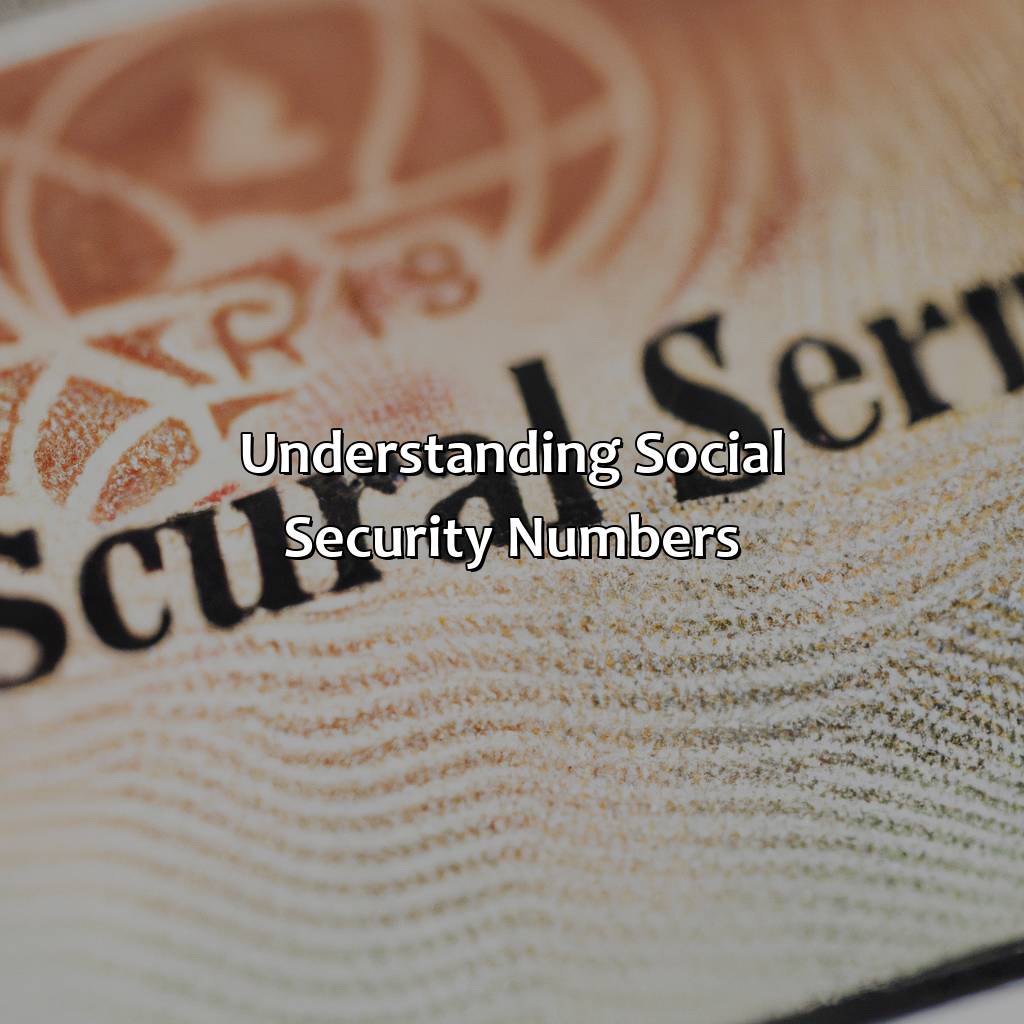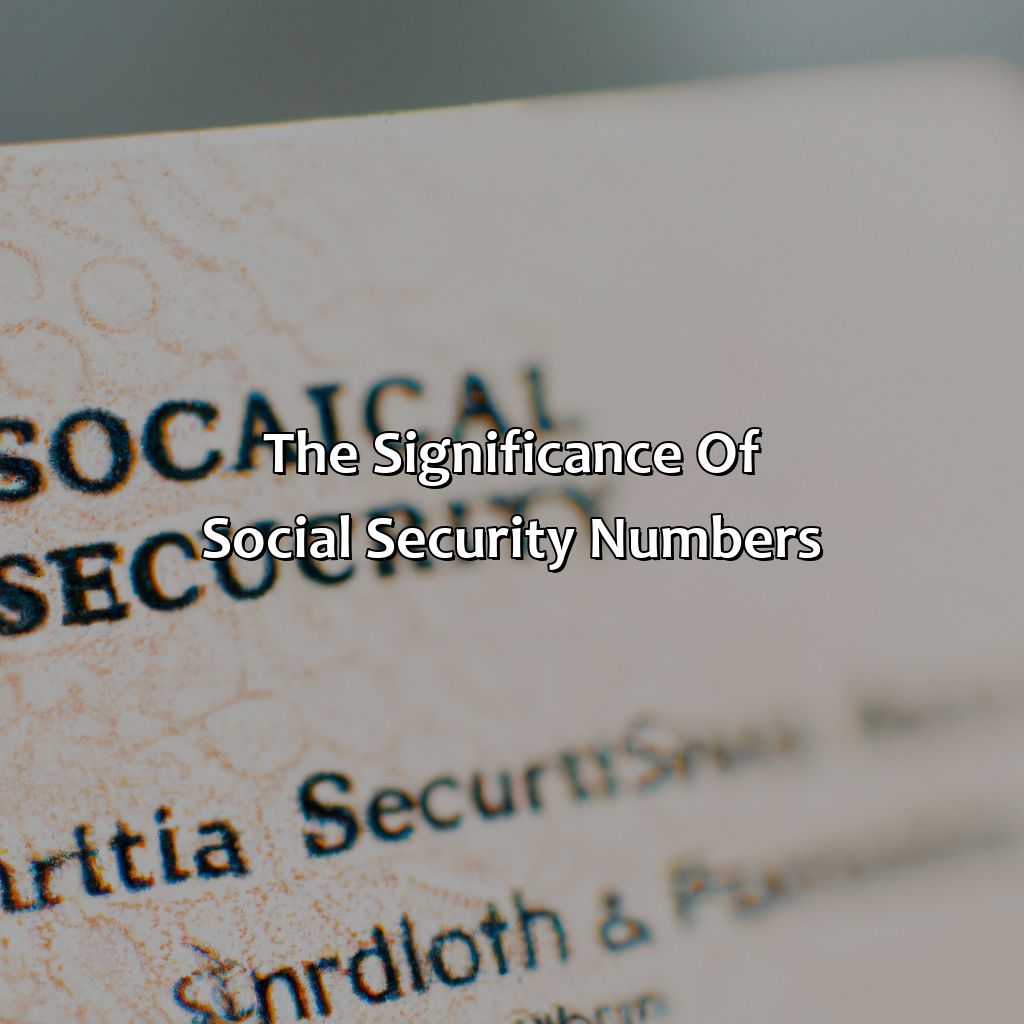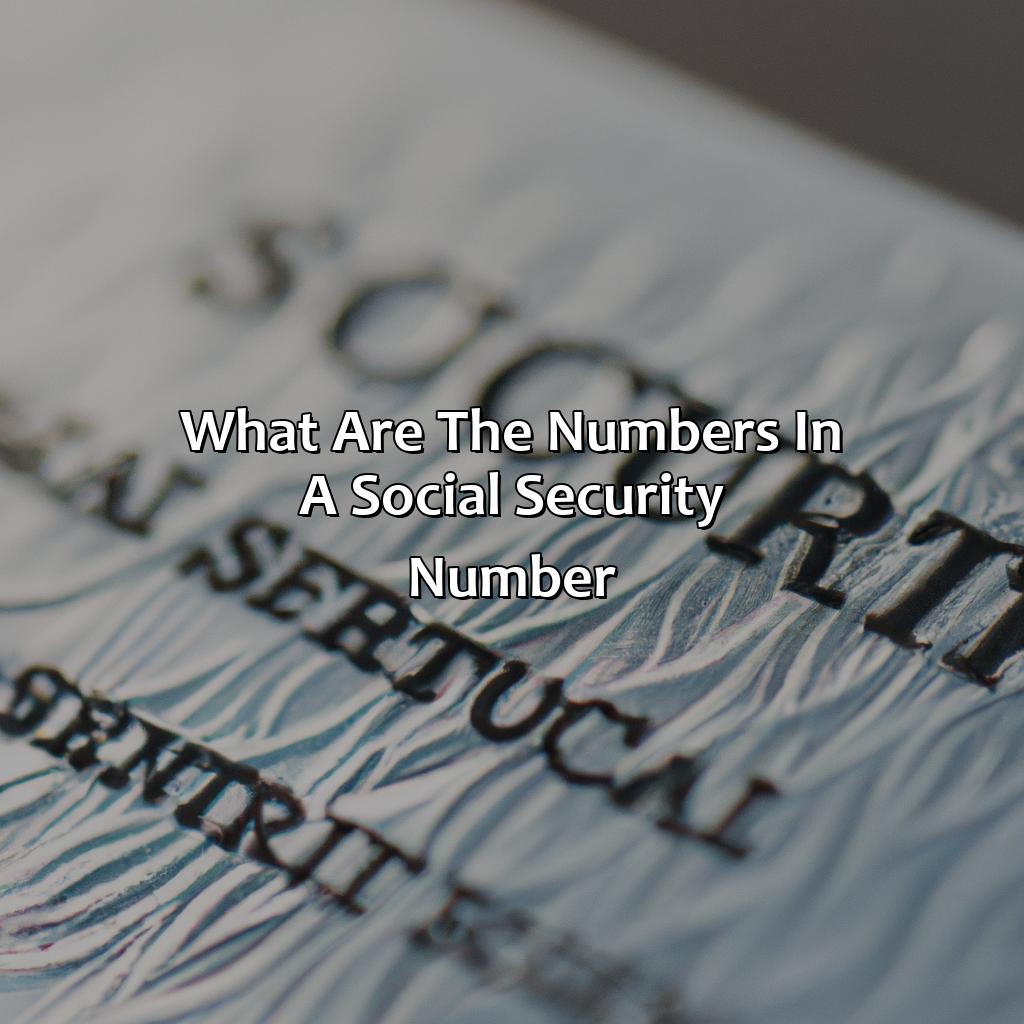What Are The Numbers In A Social Security Number?
Key Takeaways:
- Social Security Numbers are a nine-digit code used to identify individuals for a variety of purposes, including employment and government programs.
- The first three digits of a Social Security Number, called the Area Number, indicate the location where the individual received their Social Security Number.
- The next two digits, known as the Group Number, were originally intended to help identify different batches of Social Security Numbers, but are now more random.
- The final four digits, the Serial Number, are assigned in numerical order and are used to differentiate individuals within a geographical area.
- Social Security Numbers are used for identification and lifetime tracking of individuals, as well as determining eligibility for Social Security benefits and in employment and financial processes.
- Protecting your Social Security Number is essential, as it can be used for identity theft, fraudulent activities, and other malicious purposes.
Are you wondering what the nine-digit number on your Social Security Card stands for? You’ll quickly learn the importance of each numeric segment in this informative article. Discover how a Social Security Number (SSN) is constructed and how it can be used!
Understanding Social Security Numbers
Social Security Numbers, or SSNs, are unique 9-digit identifiers given to individuals in the United States for tracking their lifetime earnings and contributions to the Social Security program. The first 3 digits, known as the Area Number, represent the geographical region where the SSN was originally issued. The next 2 digits, known as the Group Number, represent a specific grouping within that region. The final 4 digits, known as the Serial Number, are assigned sequentially and are used to distinguish between individuals within the same region and grouping. It is important to protect your SSN from identity theft by not sharing it unless absolutely necessary.
One unique detail about SSNs is that they were originally created in 1935 as part of the Social Security Act, and were primarily used for tracking retirement benefits. Over time, their use expanded to include other government programs, financial institutions, and employers for tax purposes.
To protect yourself from identity theft, it is important to safeguard your SSN by keeping it confidential, not carrying your Social Security card with you, and being cautious when providing it to others. Additionally, you should monitor your credit report regularly to identify any suspicious activity. By implementing these suggestions, you can help ensure the security of your personal information and reduce your risk of identity theft.

Image credits: retiregenz.com by Harry Duncun
The Composition of a Social Security Number
Understand the structure of your Social Security Number? It’s essential. The area number, group number, and serial number all identify you. They also provide a record of your earnings for Social Security. Let’s look at the first 3 digits – the area number. Then, the next two are the group number. Lastly, the final four digits are the serial number.

Image credits: retiregenz.com by James Washington
The First Three Digits: Area Number
The primary digits in the Social Security Number, which represent Area Number, provide valuable and unique information about the location of issuance. These three digits play a crucial role in verifying the identity of an individual.
Below is a table highlighting The First Three Digits: Area Number for Social Security Numbers issued before June 25th, 2011:
| Area Number | Issuing State |
|---|---|
| 001-003 | New Hampshire |
| 004-007 | Maine |
| 008-009 | Vermont |
| 010-034 | Massachusetts |
| 035-039 | Rhode Island |
| 040-049 | Connecticut |
There are instances where multiple states share the same Area Number. However, this discrepancy is avoided by using additional information on the Social Security Number card to verify residency.
Did you know that since 1936, over 450 million social security numbers have been issued? (source: SSA.gov)
You may think group numbers in a Social Security number indicate your social status, but really they just group you together with a bunch of strangers.
The Next Two Digits: Group Number
The two following digits after the Area Number portion in a Social Security Number denote the Group Number. The Group Number determines when and where your SSN was issued. It is sequential based on regions, but it does not represent the order in which you received your SSN.
The Table:
| Area Number | Group Number | Serial Number |
|---|---|---|
The unique properties of the Group Numbers are that they apply to individuals who receive their SSN around the same time based on location. It is also an easy way to classify citizen information for administrative purposes.
Fact: The Social Security Administration started using this system of grouping numbers in 1972. (source: SSA.gov)
Your social security number’s final four digits are like a serial code, except instead of solving a murder mystery, they just identify your place in line for government benefits.
The Final Four Digits: Serial Number
The concluding four digits of a social security number have significant importance as they represent the Serial Number. It is used as an identifier to distinguish between people with the same name and birthdate. The Social Security Administration (SSA) randomly assigns Serial Numbers to individuals.
| Serial Number Range | State of Issuance |
| 001-003, 004-007, or 008-009 | New Hampshire |
| 587-699 | Assigned Where Overseas American Forces are Located – Department of Defense Civilians and Military Personnel Only |
Apart from being unique identifiers, the Social Security Administration also uses Serial Numbers to track earnings record for those eligible for benefits. Through this system, they ensure that correct credits are given to the right individual.
It was in November 1947 when the SSA started using nine-digit SSNs for their records- consisting of three segments: area number, group number, and serial number. The concept behind SSNs developed in the early years of American history when there arose a need to create a reliable identification system that would distinguish individuals who shared similar sensitive information like names and birth dates underwater military operations.
Your Social Security Number may be unique, but don’t worry, the government has plenty of copies to go around.
The Significance of Social Security Numbers
To understand the importance of Social Security numbers, explore the ‘The Significance of Social Security Numbers’ section. This section has three sub-sections:
- Identification and Lifetime Tracking of Individuals
- Eligibility for Social Security Benefits
- Use in Employment and Financial Processes
These sub-sections help us to comprehend the relevance of Social Security numbers in various areas of life.

Image credits: retiregenz.com by James Jones
Identification and Lifetime Tracking of Individuals
With the increasing importance of technology, the Identification and Lifetime Tracking of Individuals has become a crucial aspect for any government or private organization. Social Security Numbers (SSN) are one of the essential components that enable authorities to identify individuals and monitor their activity across various domains.
Below is a table that outlines some key elements of SSNs:
| SSN Element | Description |
|---|---|
| Area Number | The first three digits represent the geographical region where an individual applied for their SSN |
| Group Number | The middle two digits are assigned according to a specific chronological or geographical pattern |
| Serial Number | The last four digits are randomly generated numbers issued sequentially |
The issuance process ensures that every individual’s SSN remains unique and is used as a primary vehicle to track their employment history, financial information, and taxes throughout their lifetime.
It’s worth noting that while social security numbers offer several benefits to society, there are also potential risks associated with sharing personal details online. Therefore, it’s crucial to take measures to secure your data such as monitoring credit reports regularly.
There was once an instance where someone’s identity got stolen by criminals who used his SSN to acquire multiple loans in his name. This act greatly impacted his personal life and creditworthiness. Fortunately, after reporting this incident, he was able to regain control over his social security number and gradually rebuild his credit score.
Why hope for a retirement plan when you can hope for a zombie apocalypse? At least then you’ll have something to do with your Social Security benefits.
Eligibility for Social Security Benefits
Understanding the Criteria to Avail Benefits from Social Security
Accessing social security benefits is based on specific criteria. It is critical to meet these requirements before one can receive their entitled amount. The eligibility process considers factors like age, employment status, and disability.
Having accumulated a certain number of work credits is also an essential criterion for eligibility. Generally, ten years of working earn a person enough credit to begin availing social security benefits. It is important to note that those who have not worked for ten years may still qualify under unique circumstances.
Some people choose to delay claiming social security benefits until they reach full retirement age (FRA). Upon reaching FRA, individuals can receive the full benefit amount that they are entitled to, regardless of their continuing employment status.
As per a recent survey by data analysts at the Social Security Administration (SSA), John, a retired professor worked in academia for 35+ years and collected his SSA retirement benefit after he reached his FRA at 66&8 months!
Use in Employment and Financial Processes
A crucial aspect of social security numbers is their integration into the employment and financial processes, where they play a pivotal role. Social security numbers are an efficient identifier of individuals across various sectors, including employment management, verification processes for credit card applications, debt collections, and other financial transactions.
In addition to streamlining these processes for different organizations and institutions, social security numbers are also used to identify taxable incomes. When employers report worker earnings to the government as required by law, they include the employees’ social security numbers on those reports. Without these identification numbers, it would be difficult for employers to maintain accuracy throughout their reporting systems.
While companies may request social security numbers while employing new personnel, it is imperative not to give out this information randomly. Therefore, job seekers should prioritize researching a company’s credibility before offering such valuable personal data. In cases where disclosure of an individual’s personal information becomes necessary due to legal requirements or other preapproved purposes, caution is still advised.
To enhance confidentiality and safeguard against identity theft that could result from hackers accessing databases containing employees’ sensitive information at unguarded moments in the digital age, companies can use encryption technology and electronic software keeping unauthorized persons away from valuable data and ensuring compliance with industry standards and national regulations.
Five Facts About Social Security Numbers:
- ✅ Social Security numbers consist of nine digits. (Source: Social Security Administration)
- ✅ The first three digits of a Social Security number are known as the Area Number, representing the geographical region where the number was issued. (Source: Social Security Administration)
- ✅ The middle two digits of a Social Security number are known as the Group Number, which has no specific meaning but was used for administrative purposes. (Source: Social Security Administration)
- ✅ The last four digits of a Social Security number are known as the Serial Number, which were originally assigned based on the order in which the Social Security cards were issued. (Source: Social Security Administration)
- ✅ Social Security numbers were first issued in 1936 to track workers’ earnings and determine their Social Security benefits. (Source: Social Security Administration)
FAQs about What Are The Numbers In A Social Security Number?
What are the numbers in a social security number?
The numbers in a social security number are a nine-digit code used to identify a person for tax purposes.
What is the significance of the numbers in a social security number?
The first three numbers in a social security number indicate the geographic region where the person was issued the number. The next two numbers signify the group number, which is used to differentiate people with the same geographic region and birthdate. The last four numbers are assigned sequentially.
How are social security numbers generated?
Social security numbers are generated using a specific algorithm that takes into account the geographic region where the person was issued the number, as well as their birthdate and group number.
Is it safe to share the numbers in my social security number?
It is generally not recommended to share your social security number with anyone, as it can be used for identity theft. However, certain organizations may require your social security number in order to verify your identity.
Can I change the numbers in my social security number?
No, social security numbers are assigned by the Social Security Administration and cannot be changed unless there is a compelling reason, such as identity theft or harassment.
What should I do if I suspect someone else is using my social security number?
If you suspect someone else is using your social security number, you should contact the Social Security Administration immediately and report the issue. You should also monitor your credit report and take steps to protect your personal information.
